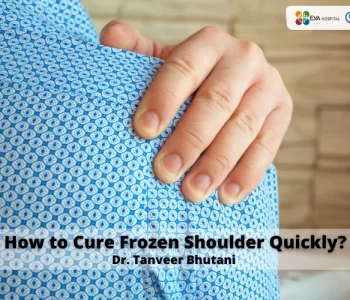 Eva Hospital
Eva Hospital
How to Cure Frozen Shoulder Quickly?
Introduction
Severe pain in the shoulder when moving and while resting, a pain that affects sleep and limits your mobility in any way, especially while rotating the arm above shoulder level, can indicate frozen shoulder exercises syndrome
A disease that attacks the shoulder joint, medically known as Adhesive Capsulitis, frozen shoulder is difficult to bear.
Pain and stiffness develop gradually, get worse, and eventually go away. However, the full recovery can take up to 3 years.
The Shoulder consists of three bones that form a connection called a ball-and-socket joint, namely the upper arm (humerus), shoulder blade (scapula), and collarbone (clavicle).
The tissue surrounding the shoulder joint that holds everything together is called the shoulder capsule.
The frozen shoulder makes the capsule so thick and tight that it’s hard to move. Scar tissue forms and there is a reduction of synovial fluid, a liquid that keeps the joint lubricated.
This leads to further limiting of the motion.
Frozen shoulders can be very painful, making simple tasks like dressing and bathing impossible.
Symptoms and Signs of a Frozen Shoulder
- Shoulder pain
- Stiffness
- Loss of freedom of movement.
- Limiting the range of shoulder movement on trying to move the joint.
- Increased pain in the shoulder when used.
- A pain that worsens at night
Stages of a Frozen Shoulder
The symptoms of frozen shoulder are divided into three stages. They slowly get worse and go away within 2 to 3 years.
Freezing or Painful Stage:
Pain in the shoulder while moving it, which gradually increases, making shoulder movements more difficult and stronger and hurting more at night. This phase generally lasts from 6 weeks to 9 months.
Frozen Stage:
The pain does not worsen and may get better at this stage. However, the stiffness in the shoulders may worsen. This stage can last for 4 to 6 months or even more, restricting your movement, and making daily activities even harder.
Thawing Stage:
The range of motion becomes more comfortable and ultimately returns to normal. The pain is much better, but sometimes it may return too. This takes anywhere between 6 months and two years.
Causes of Frozen Shoulder
A frozen shoulder can be caused by an injury of the shoulder, including tendinitis, bursitis, and rotator cuff syndrome.
Patients with diabetes, chronic shoulder arthritis, and having had breast surgery are at a higher risk. Frozen shoulder usually affects people aged between 40 and 60 years and it happens in more women than men.
Diagnosis
A physical exam to check how badly the shoulder hurts and how far it moves is usually enough to diagnose a frozen shoulder. However damaging tests such as X-rays, ultrasound, or MRI to rule out other problems like arthritis or a torn rotator cuff can also be done
Treatment
The main aim of the treatment is controlling the shoulder pain and preserving as much range of motion in the shoulder as possible. There are many ways to alleviate pain and ease the condition.
Most frozen shoulder treatments involve:
Physical Therapy:
Physiotherapy is the most popular treatment for frozen shoulders. The therapist recommends and teaches range-of-motion exercises to help recover as much mobility in the shoulder as possible by stretching the shoulder joint and regaining lost movement.
Any improvement can take at least a few weeks to nine months. But if no improvement is noticed after six months of exercise every day, one should talk to a doctor for other options.
Medications:
Pain relievers, such as aspirin and ibuprofen can help lessen pain and inflammation attributed to frozen shoulders. In some cases, anti-inflammatory drugs are recommended to treat pain and reduce joint inflammation.
Steroid injections:
Injecting corticosteroids into the shoulder joint help ease pain and improves range of motion, especially in the early stages of a frozen shoulder
Joint detention:
Injecting sterile water into a joint capsule can help stretch it, allowing an easier movement of the shoulder.
Surgery:
However, if the symptoms do not improve with therapy and other conservative methods or if the patient is looking for a quick solution to the problem, the doctor can recommend surgery in which the surgeon removes scar tissue and adhesions from inside the shoulder joint.
The aim of this surgery is to stretch & release the stiff capsule of the joint.
The two most popular methods of surgery are
Manipulation: It is a procedure where the surgeon moves the shoulder when the patient is under anesthesia. The shoulder joint is then moved in various directions by the doctor to loosen tight tissue.
Arthroscopic capsular release: A relatively small operation performed as a “key” operation, the tight capsule from the joint is removed with a special lighted, tubular instrument inserted through small incisions.
Conclusion:
If you have pain in your shoulder or the movement is painful, a Free orthopedic doctor near me. The doctor will recommend medicines and physical therapy to ease the pain.
Physical therapy and pain killers can help you control your pain and increase shoulder mobility but it can take up to 3 years for the shoulder to get back to normal.
But if you are looking for a quicker cure, then surgery is a good option and when performed by a competent surgeon, it can restore mobility and set you free from pain in under three months.
Dr. Tanveer Bhutani at Eva Hospital has been helping people lead a pain-free life by very competently treating frozen shoulder problems.